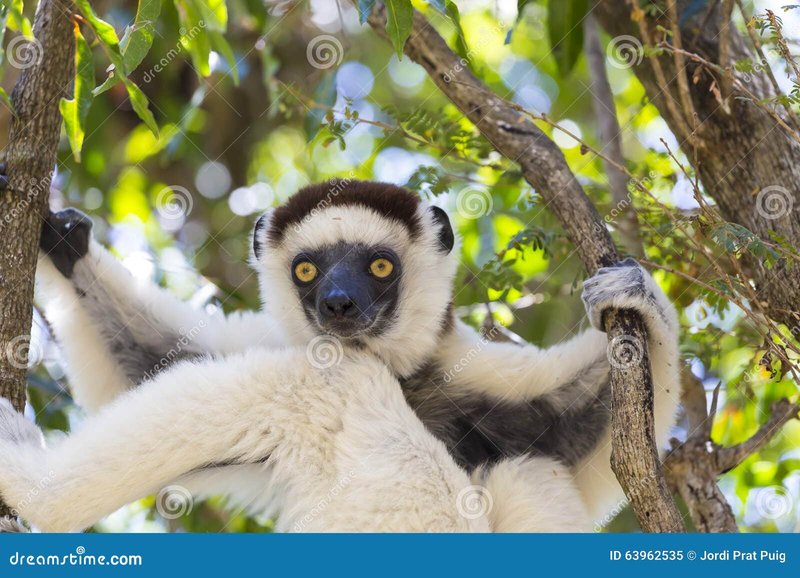
You might be wondering why people often get it wrong. Sometimes, it’s just a matter of assumptions based on limited knowledge or a fun twist in how we talk about animals. The sifaka, with its impressive leaps and playful demeanor, invites curiosity. But it also becomes a canvas where myths can easily paint over the reality. So, grab your favorite beverage and let’s chat about what’s true and what’s simply not when it comes to this charming lemur.
Myth 1: Sifakas Are Monkeys
One of the biggest misconceptions is that sifakas are monkeys. While they may have some features like monkeys, sifakas are actually part of the lemur family. Here’s the thing: lemurs and monkeys belong to different evolutionary branches. Lemurs are primates, but they are more closely related to lorises and tarsiers than to monkeys.
Think of it this way: if primates were a family reunion, sifakas would be a unique cousin that doesn’t quite fit with the more common monkeys. Lemurs, including sifakas, are native to Madagascar, while monkeys can be found all over the world. This geographic separation plays a big role in their physical and behavioral differences.
You might also notice that sifakas have distinct characteristics, like their large eyes and fluffy bodies. These traits help them thrive in their forest homes but also set them apart from the more agile and sometimes cheeky monkeys you may be familiar with.
Myth 2: Sifakas Are Poor Climbers
Another common myth is that sifakas struggle when it comes to climbing trees. On the contrary, sifakas are extraordinary climbers and leapers! Their long legs and arms make them perfectly adapted for life in the trees, allowing them to leap from branch to branch with grace and precision.
Imagine a gymnast bouncing across the floor—sifakas display the same kind of finesse as they navigate their forest habitat. Instead of climbing slowly, they often engage in a behavior known as “vertical clinging and leaping.” This means they cling to a tree trunk and leap to another tree with ease. When you see them in action, it’s clear that they’re built for this life, making it a joy to watch.
In reality, they excel where other animals might struggle. Their ability to move smoothly through their environment ensures they can escape predators and find food. So, next time someone tells you sifakas can’t climb, feel free to show off how wrong they are!
Myth 3: Sifakas Are Solitary Animals
You might envision the sifaka as a lone wolf, but in reality, these lemurs are quite social! They live in family groups, usually made up of around five to twelve individuals. This social structure provides benefits for the entire group, from foraging for food to protecting each other from threats.
Think about it: living in a group allows them to communicate effectively and share resources. They often groom each other, which helps strengthen social bonds and keeps their fur clean. You might even spot them engaging in playful behavior, especially among the younger sifakas as they interact and learn from each other.
Staying in groups also allows them to be more alert to dangers. With more eyes on the lookout, they’re less likely to become prey to predators. This community spirit is a fascinating aspect of their behavior that often gets overlooked.
Myth 4: Sifakas Are Herbivores Only
Another myth is that sifakas are strictly herbivores. While it’s true that their diet mainly consists of leaves, fruits, and flowers, they’re a bit more flexible than that. Sifakas may occasionally consume insects as a source of protein, especially during certain seasons when other food is scarce.
Picture them as selective eaters when it comes to their meals. They are known to prefer young, tender leaves that are easier to digest and pack a nutritious punch. However, they also adapt based on seasonal availability. Their ability to switch things up in their diet showcases their intelligence and adaptability in the wild.
Understanding their omnivorous tendencies can shed light on why they thrive so well in Madagascar’s diverse ecosystems. It also helps dispel the notion that they only munch on greens like a salad-loving rabbit!
Myth 5: Sifakas Are Endangered Because of Human Activity Alone
While it’s true that sifakas are facing significant threats due to habitat loss and human activity, it’s a bit of a simplification to say that humans are the only factor in their endangerment. Other challenges, such as climate change, play a role in their survival too.
Deforestation, driven by agriculture and logging, poses a significant threat to their habitat, but let’s consider how the changing climate affects their food sources and living conditions. Sifakas need stable environments to thrive, and as their home changes, it leads to more challenges for their populations.
So while human actions have a huge impact, it’s not the only cause of their decline. Protecting sifakas requires a holistic understanding of all the pressures they face and efforts from conservationists to address these issues effectively.
Myth 6: Sifakas Have No Natural Predators
It’s easy to assume that because sifakas are such skilled leapers, they might not have to worry about predators. However, this isn’t the case! Sifakas face threats from a variety of predators, including birds of prey and *fossa*, a carnivorous mammal native to Madagascar.
The fossa is often compared to a small cougar and is known for its agility in climbing trees, making it a formidable opponent for sifakas. Even with their impressive leaping abilities, these lemurs must stay alert and vigilant.
Their social structure helps them face these threats. By living in groups and using their keen senses, they can better detect potential dangers. It’s a testament to their survival instincts and the importance of community in the animal kingdom.
Myth 7: Sifakas Only Live in Madagascar
While most people associate sifakas with Madagascar, some might think they’re exclusively confined to a certain region. However, you can find different species of sifakas across various parts of Madagascar! Each species has adapted to its specific habitat, whether it be forest, scrubland, or dry regions.
Exploring the diverse habitats across the island, you’ll encounter species like the diademed sifaka and the Crowned sifaka, each with unique traits and behaviors. This diversity showcases the rich biodiversity that Madagascar is famous for, making it a treasure trove for biologists and nature enthusiasts alike.
Knowing that sifakas inhabit various environments allows for a deeper appreciation of their adaptability and the importance of conserving different habitats across Madagascar.
Sifakas are fascinating creatures that embody the rich biodiversity of Madagascar. Unfortunately, myths and misconceptions can cloud our understanding of these animals. By dispelling these misunderstandings—whether about their diet, social behavior, or habitats—we gain a better appreciation for their place in the ecosystem.
As we continue to learn more about the sifaka and its unique characteristics, let’s remember the importance of conservation efforts. By protecting their habitats and understanding their needs, we can help ensure that future generations will marvel at these incredible lemurs. So next time you hear someone mention sifakas, share what you’ve learned and help spread the truth about these captivating primates!

